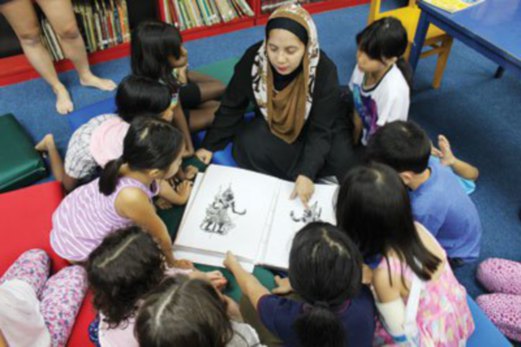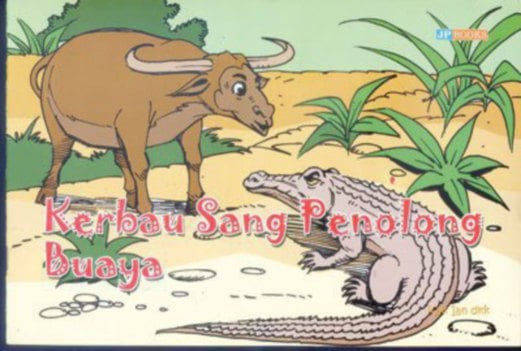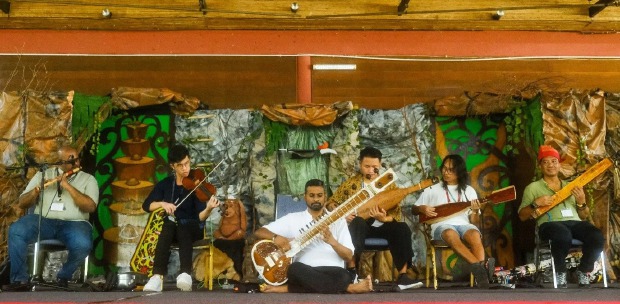Like our forest, if we don’t take steps to preserve our fables, they too will disappear, writes ninotaziz
IT was way past dusk and there we were enjoying camp night at the Forest Reserve Institute of Malaysia. There were no lights or candles lit, and not a single torchlight was in sight. In deference to the camp guide, we city dwellers, armed with mosquito repellents, kept absolutely silent. The forest was alive with the sounds of the night, a cacophony of rhythmic chaos, screeching monkeys and things that scurried on the ground. The sounds of the river in the distance seemed to be magnified. The jungle was breathing. We were all suddenly aware of just how small we were in the midst of nature.
FOREST FABLES
That trip taken many years ago was an exercise to help children from the ages of 9 to 16 to imagine what the forest was like maybe 10,000 years ago. It’s estimated that our ancient forest is more than one million years old, and is among the oldest in the world. Our ancestors depended on the jungle for shelter and food. Everything was believed to possess a spirit, including animals in the wild. Naturally, early storytellers shared folk stories centred on the creatures of the forest, stories which indirectly imparted many valuable life lessons.
From the from Japanese tanuki-stories to Panchatantra tales in India, and the African trickster tales of Anansi, the Spider, these animal lores continue to delight children and adult alike, with each continent having its own collection of Kancil-like tales. These stories are certainly unique to each geographical area given the diverse animals and climate. Professor G L Koster, world expert in Asian cultures, offers: “There need be no doubt that much of the animal tales give us an insight into the world-view intrinsic to the minds of the peoples who once produced them. That world view is rapidly getting lost now . but it is worth preserving the knowledge of it, however imperfectly perhaps, for posterity.”
Long ago, we built communities on the forest fringe, making sure we lived within nature’s rules. It’s inevitable that the elderly used stories to explain these rules, often involving animals. This form of storytelling became an informal form of learning and imparting wisdom. The Orang Asli was particularly fond of stories that explained natural phenomenon like rock formations, floods and other natural disasters.
ANIMAL APPEAL
Among the most popular legends to arise from our forest are the tales of the mischievous, witty and wise mousedeer. From oral storytelling, they were quickly printed by local publishers Fajar Bakti and Dewan Bahasa Pustaka for the public as well as for school readers. The mousedeer stories have gone on to receive international acclaim.
Yet we are in danger of forgetting these charming and quintessential stories. There is also a situation where we are importing foreign fables as our own. While it is true such fables have a way of moving from one continent to the other, enriching lives as they make their way through the global village that is our Earth, we want to ensure local content and stories imbued with our culture continue to survive. The Sang Kancil stories are known by various titles. Among the most famous are Sang Kancil’s adventures with the crocodile, the buffalo, and the hunter. Dr Annabel Teh Gallop, lead curator, Southeast Asia at the British Library, recently blogged about Sang Kancil. She wrote: “Malay folklore is full of accounts of how the mousedeer gets the better of the other animals by his intellect and trickery. But in addition to oral tales and children’s’ stories, there is also a written epic in Malay, the Hikayat Pelanduk Jenaka or Tale Of The Wily Mousedeer, probably dating from the 15th or 16th century, which is a highly sophisticated literary composition.”
She adds: “Animal stories are of enormous appeal all over the world, from Aesop’s Fables to stories of Sang Kancil, and in all cultures. To be honest, I don’t think animal fables are more important to Malays in particular; I think they are important in all cultures.”
Some stories like The Mousedeer and the River Otters are such classics, but regretfully, are disappearing. So what do we do?
TO PRESERVE, OR TO EVOLVE
From oral storytelling to books to beautiful picture books, animal fables have evolved with time. The great thing is that today, through television and films, it’s possible to combine the elements of oral storytelling, with sounds, character play and great visuals. With the Internet, these stories can reach a much wider audience on multiple platforms.
However, the best way for our children to really appreciate this heritage is really to experience it. A few years ago, I conducted a storytelling session at a private school. The students performed a mini-theatre performance of Sang Kancil and his friends, Che Siti Wan Kembang and Puteri Santubong among others. Through storytelling and theatre performance, it is hoped that their experience will spark creativity and enrich our younger generation’s lives.
IMPORTANCE OF CULTURAL INFLUENCES
A strong foundation in culture is invaluable, intangible as it may appear to be. However, we know that what our children read and experience will influence them later in life. We can deduce that this common culture and stories can become a shared bond among our young. On a very simple level, cultural activities can encourage creativity, productive meaningful engagement and learning.
Anas Zubedy, founder of the Say Something Nice Campaign, a drive to encourage positivity among Malaysians, offers: “Folklore is the way we keep concept and ideas current, regardless of time. Folklore can provide us with a platform to relive the spirit of our past.”
Cultural influences can actually be the very platform to propel ideas into great ventures. When Perodua came up with its first fuel-saving model, they named it Kancil, alluding to the fact a Kancil is small, clever and to a certain extent, full of adventure. The advertisements and idea behind the Kancil story worked overwhelmingly well and the Kancil became a bestseller in its class, perhaps because of its connection with the heart of its buyers.
We need to understand the role of cultural elements especially folklores and fables in our society to appreciate it. It is a gift, and we should take steps to ensure its survival for future generations to enjoy, and appreciate.
ninotaziz believes that our legends and folklores are the memories of our ancient civilisation. Our Hikayat belongs to all of us. To protect. To love. To share. To cherish.
A Good Turn
SANG Kerbau was one of the most good-natured animals of the jungle. He worked hard all day in the hot sun and lazed around in the mud to cool off. He didn’t even mind it when the tiong and other birds landed on his big broad back to perch. One day, enroute to the river for a drink, the buffalo heard a crying bellow, as if someone was in great pain. He turned and at the corner of his great big horns he saw a crocodile by the riverbank. A huge tree trunk had fallen on its back and kept it pinned to the ground.
“Adoi, adoi, my back is breaking
Oh, Sang Kerbau, please help me!”
Moved by the animal’s crocodile tears and pitiful pleading, Sang Kerbau forgot that Sang Buaya is a treacherous animal never to be trusted, and said,
I will help you, Sang Buaya
Don’t cry so, don’t despair
With his strong horns, he heaved the log. Sang Buaya was free. With a quick turn, the ungrateful crocodile caught the buffalo by its hind leg with its jaws. It dragged poor Sang Kerbau to a marshy plot, ready to devour its victim. The bewildered buffalo cried, “What injustice is this?” it was at that point that a Sang Kancil happened to stroll by and he witnessed the scene.
Sang Kerbau begged the clever mousedeer to make Sang Buaya see reason. Sang Buaya gave his account and Kancil nodded in agreement. “In the jungle,” he pronounced, “one must take advantage of situations.”
The three were silent for a while, the words of Sang Kancil playing on their minds. Sang Kerbau had tears running down his cheeks. Sang Buaya grinned and had a greedy gleam in his eyes. Sang Kancil thoughtful, stroking his chin with his front legs, said, “However, it seems ludicrous to suggest that Sang Kerbau is that strong. I believe Sang Buaya, you’re making this up to prove you’re right and Sang Kerbau, wrong.”
Sang Buaya was quick to say, “That’s not true! I shall prove this to you.”
He relaxed his mighty jaw and asked Sang Kerbau to show Sang Kancil what happened earlier. Sang Kerbau sadly lifted the trunk up high. And Kancil quickly cried, “Put it on Sang Buaya’s back again, Sang Kerbau!”
“You see, Kancil, I was right,” said Sang Buaya. “Sang Kerbau is strong enough. He did free me, stupid though it seemed.”
Sang Kancil smiled and said, “Now, Kerbau, you leave this place now. No one is to help Sang Buaya until he learns all about gratitude.”









